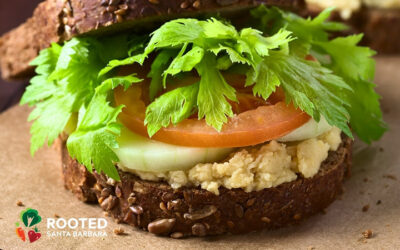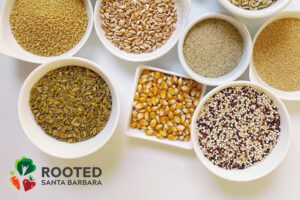 I’d like to believe there’s a general consensus that whole grains are an important part of a healthy diet. I mean, if even Fruit Loops tout “Made with Whole Grains” they must be important, right?
I’d like to believe there’s a general consensus that whole grains are an important part of a healthy diet. I mean, if even Fruit Loops tout “Made with Whole Grains” they must be important, right?
It’s a selling feature to relieve us parents of the guilt of buying sugar laden cereals for our kids – or ourselves. The truth is, whole grains are incredibly important – but the types of grains that do a body good are most definitely not found in Fruit Loops!
What Does “Whole Grain” Really Mean?
A whole grain is just that – whole – as in, it’s still intact. The entire grain/seed is as close to its original form as possible with the bran, the germ and the endosperm still forming one complete kernel or grain. When you’re reading a label in the store, “made with whole grains” means there is an ingredient in the package that at one point was an intact whole grain. If the product is processed, the whole grain has likely been processed and is now indistinguishable.
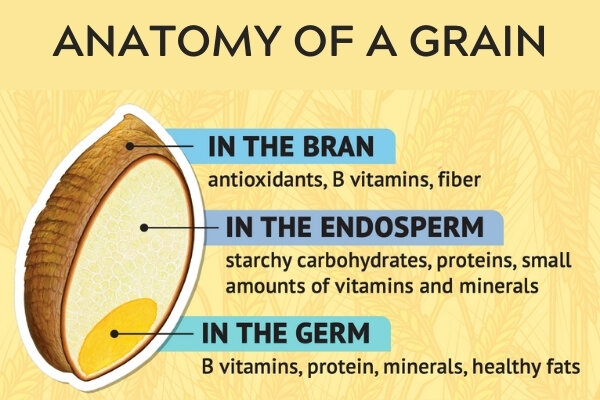
Of course, there are times when we must minimally process a grain so that we can achieve certain kitchen triumphs – like turning a grain into a flour which then becomes a delicious bread, a decadent cake, or incredible fresh pasta. We still prefer to use whole grains whenever possible instead of overly processed white flours, which have been stripped of nutritional value and fill our bodies with empty promises. Types of whole grain flours you may see in the grocery store include:
- Oat flour
- Buckwheat flour
- Whole wheat flour
- Amaranth flour
- Spelt flour
Why Are Whole Grains Important?
Many health benefits are attributed to diets rich in whole grains; reduced risk of heart disease, cancer, type-2 diabetes, stroke, and obesity are among the most important.
Whole grains are loaded with fiber, which help maintain healthy cholesterol levels and keep everything moving inside by supporting our microbiome, where our gut microbes ultimately break down what we eat. Whole grains are rich in phytonutrients which are important for a variety of body functions like forming new cells, regulating thyroid function, carrying oxygen in the blood and maintaining a healthy and robust immune system. Whole grains also help us feel fuller for longer, helping us maintain a healthy weight.
Sadly, with the popularity of gluten-free and low-carb diets, many people are skipping out on grains altogether – a total disservice to their long-term health. While there are some folks that have celiac disease and absolutely must avoid gluten, this accounts for less than .01% of the population. Most people who skip out on grains and gluten (wheat, rye and barley) should skip only highly processed foods and leave in all the intact, whole grains for their incredible health benefits – including a 22% lowered risk of death from all causes for people who eat four servings per day.
The Most Popular Whole Grain – Rice
If your interest is piqued – let’s dive a little deeper. Grains are abundant on earth and are a staple ingredient within the longest lived cultures in the world. The most common of course being rice.
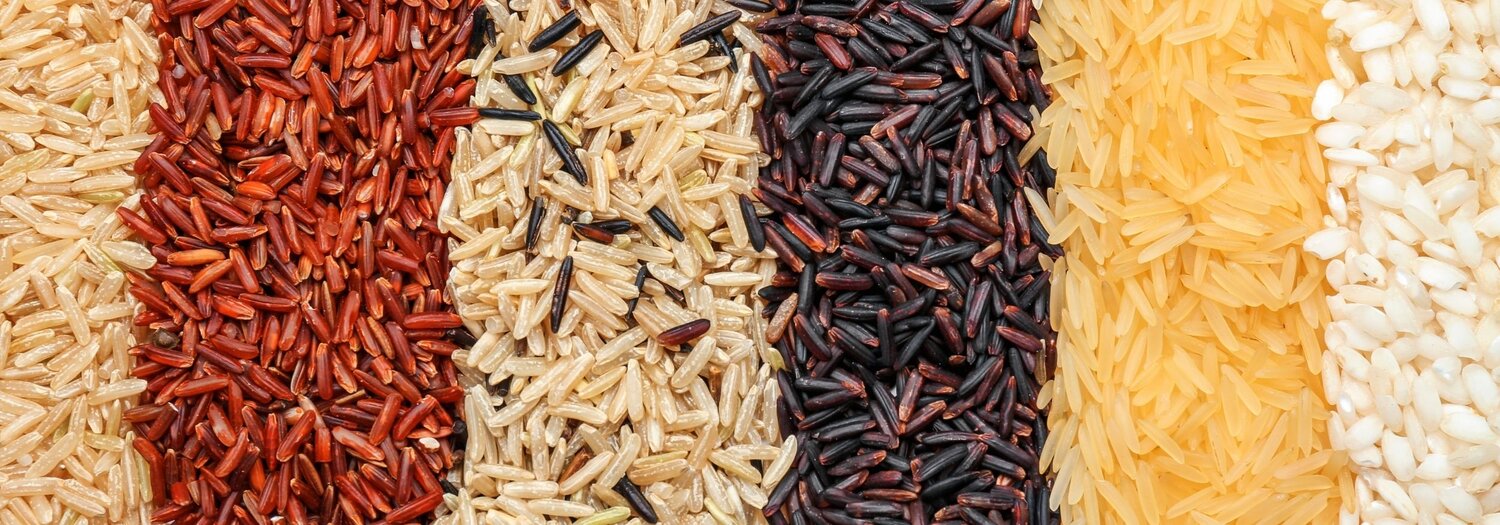
Sushi, rice & beans, kedgeree, paella, rice pudding, jambalaya, congee, curry, fried rice, horchata, kichari, maifun, mochi, nasi goreng, pilaf, risotto… it’s nearly impossible to think of a culture that doesn’t have rice as a centerpiece to its traditional meals.
There is a lot of talk about arsenic levels in rice and we’d be remiss to not mention it, but we’ll let Dr. Michael Greger explain it further.
Other Types of Grains
But, rice is just the tip of the iceberg when it comes to grains – here are 14 more to consider when perusing the grocery shelves over the next few months. It’s fun to mix things up.
Quinoa (Keen-Wah)
A complete protein, meaning it contains all essential amino acids making it a tremendous addition to any plant-forward diet. Quinoa makes a great base for bowls or mix in for salads.
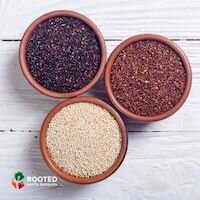
Oats
One of the most protein rich cereals on earth, oats contain a unique phytochemical that has been shown to protect the body and reduce LDL cholesterol (the “lousy” one). A breakfast of oatmeal with fresh fruit and nut can keep you full and satisfied, especially on a cold morning.
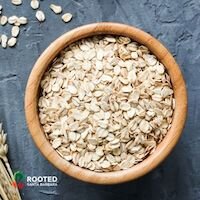
Amaranth
A staple food of the Aztecs, this ancient grain is a complete protein and higher in iron, potassium & lysine than other grains. It also contains lunasin a peptide believed to have anti-inflammatory and cancer preventative benefits. Great for pancakes, salads, tabbouleh & bread.
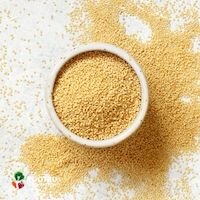
Freekeh
Besides being fun to say, this Middle Eastern grain is a nice replacement option for rice or to add a heartier texture to salads, soups and bowls. It packs a particularly high nutritional punch because it is harvested when it’s young, akin to micro greens.
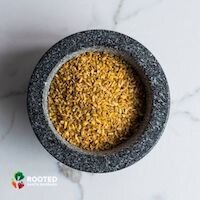
Buckwheat
Used extensively in Asia dating back to 6000 BCE, commonly found as whole groats, flour, or in soba noodles. Buckwheat has a high concentration of all essential amino acids, making it a protein rich grain and, contrary to what its name implies, it’s gluten-free.
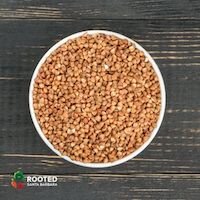
Fonio
A climate-smart, ancient, West African grain known in Mali as “The Seed of the Universe”. It has a mild nutty flavor and works well in veggie burgers, gluten free baking, hot cereals and pilafs.
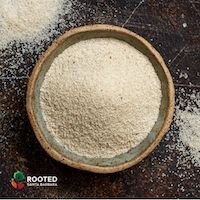
Millet
Technically a grass seed, this grain-like whole food is a staple ingredient in daily meals of ⅓ of the world’s population. Naturally gluten-free, its fluffy texture lends itself well to porridges and pilafs as it takes on whatever flavors it is surrounded by, making it very versatile.
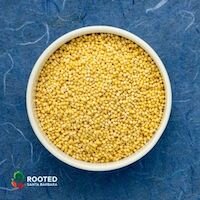
Barley
One of the first cultivated grains on earth, barley’s low glycemic properties have actually been shown to greatly improve insulin sensitivity, LDL cholesterol, and when used as a direct replacement for white rice – proved to reduce visceral fat.
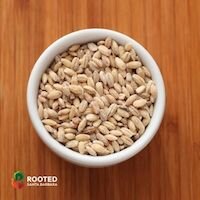
Teff
Grown in Ethiopia and Eritrea for thousands of years this mild and nutty, gluten-free grain is great in porridge, stew, pilaf and salads. Teff is officially the world’s smallest grain but it still packs a nutritional punch and has higher levels of both iron and lysine and a lower glycemic load than most grains
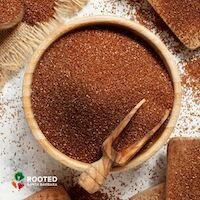
Triticale
A hybrid of wheat and rye – higher in protein but lower in gluten than either. More commonly used in agricultural cover-crop and fed to cattle but actually makes for a great cereal or addition to salads, and can be ground up and used as a flour.
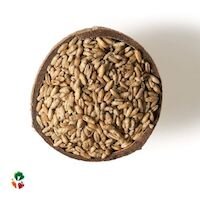
Sorghum
According to the Whole Grains Council, Sorghum is the fifth most important grain in the world, but it is mostly unknown in America outside of livestock feed and biofuel. This highly adaptable, drought resistant crop is becoming more and more common as a highly fibrous and nutritious, gluten-free grain option for baking, salads, stews and even an alternative to popcorn!
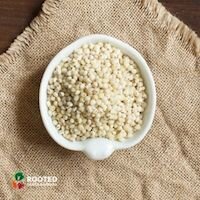
Whole Wheat
(includes Einkorn, Emmer, Kamut & Spelt)
The main culinary uses of wheat are wheat bran, wheat germ, semolina, farro, couscous, bulgur, puffed wheat, wheat flakes and manifests as breads, pastas, and cereals. Whole wheat is high in insoluble fiber, making it a great gut supporting, prebiotic food.
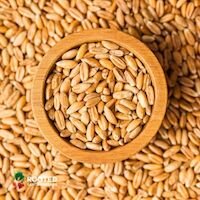
Corn
Although lower in nutrients than most grains, it’s still high in fiber and incredibly versatile. Also known as maize, corn manifests as corn on the cob, pop corn, corn starch, corn meal (think tortillas and polenta), grits and porridge. Corn is grown widely around the world as it is a cheap and sweet grain and is easy to load into an endless list of processed foods but in its whole grain form, we approve of its fiber content.
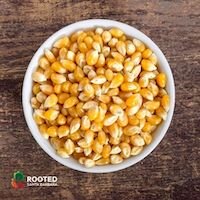
Jump on the Grain Train
Not only are grains a great source of fiber, protein and carbohydrates, they are also wildly versatile and tend to be incredibly affordable, especially when purchased in bulk. Sure, skip the refined stuff but for your long-term health don’t limit your intake of whole, intact grains!
It should also be noted that many of the digestive sensitivities that some people experience with grains is likely due to the other items in the ingredients list and not the whole grain itself. Though definitely be sure to rinse all grains prior to cooking and cook all grains per the packaged instructions.
Pro-tip: stick to the grain, the whole grain and nothing but the grain!
Need a little more inspiration? Here are 30 vast and varied recipes compiled by our friends over at One Green Planet.
Emma Malina is a plant-based nutrition educator and food-skills instructor based in Santa Barbara, CA who empowers individuals and families worldwide to optimize their health and prevent chronic disease through nutrition education, cooking classes, coaching, and online resources through her business Basking in Goodness.
Chickpea “Tuna” Sandwich
Chickpea “Tuna” Sandwich Chickpeas, or garbanzo beans, are amazing little powerhouses full of nutrition and fiber....
Team Member Spotlight: Layne Hayward
A growing network of community members is powering Rooted Santa Barbara - let’s meet the team! Each month we’re...
The True Cost of Food in America
A new Rockefeller Foundation report calculates the true cost of food in the U.S., including the impacts on our health,...
Supporting Our Work - We’re currently an all-volunteer organization and we see incredible room and need to grow over the coming year. We understand that this time has enormous challenges for everyone, so while we’ll be seeking support to help roll our vision forward, we’re also thinking creatively to keep our costs low to efficiently build resources and deliver programming at low to no cost to our community. If you’d like to support our work, we hope you’ll consider making a donation to one of our giving programs through our community partner, the Santa Barbara Foundation!

